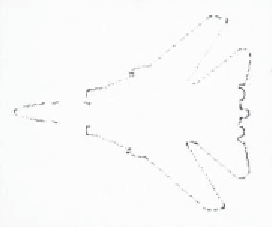Image Processing Reference
In-Depth Information
Figure 4.33
Curvature detection via curve fitting (via κ
(
t
))
is not evident. In the next chapters we will show how to find simple curves in a robust way.
We shall show, for example, how to find circular arcs. By using this robust fitting for each
image pixel, then the curvature could be computed as the inverse ratio of a circle.
4.6.3
Measuring curvature by changes in intensity
As an alternative way of measuring curvature, we can define the curvature as a function of
changes
in
image intensity
. This derivation can be based on the measure of angular changes
in the discrete image. We can represent the direction at each image point as the function
ϕ (
x
,
y
). Thus, according to the definition of curvature, we should compute the change in
these direction values along the image edge (i.e. along the curves in an image). The curve
at an edge can be locally approximated by the points given by the parametric line defined
by
x
(
t
) =
x
+
t
cos(ϕ
(
x
,
y
)) and
y
(
t
) =
y
+
t
sin(ϕ
(
x
,
y
)). Thus, the curvature is given by the
change in the function ϕ
(
x
,
y
) with respect to
t
. That is,
(,
xy
t
)
=
(,
xy
x
)
(,
xy
y
)
xt
t
()
+
yt
t
()
(,
xy
) =
(4.47)
where ∂
x
(
t
)/∂
t
= cos(ϕ ) and ∂
y
(
t
)/∂
t
= sin(ϕ ). By considering the definition of the gradient
angle in Equation 4.13, we have that the tangent direction at a point in a line is given by
(
x
,
y
) = tan
-1
(
Mx
/(-
My
)). From where we can observe that
2
2
2
2
cos(ϕ
) = -
My
/
Mx
+
My
and sin(
) =
Mx
/
Mx
+
My
(4.48)
By derivation of
(
x
,
y
) and by considering these definitions we obtain
(,
xy
)
Mx
x
My
x
My
y
Mx
y
1
2
2
=
My
-
MxMy
+
Mx
-
MxMy
3
2
(
Mx
2
+
My
2
)
(4.49)
This defines a
forward
measure of curvature along the edge direction. We can actually use
an alternative direction to measure of curvature. We can differentiate
backwards
(in the

























